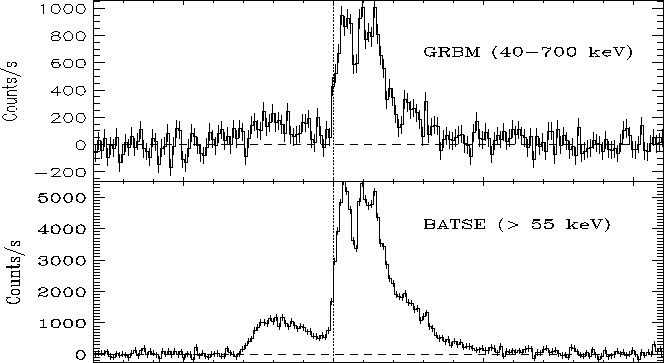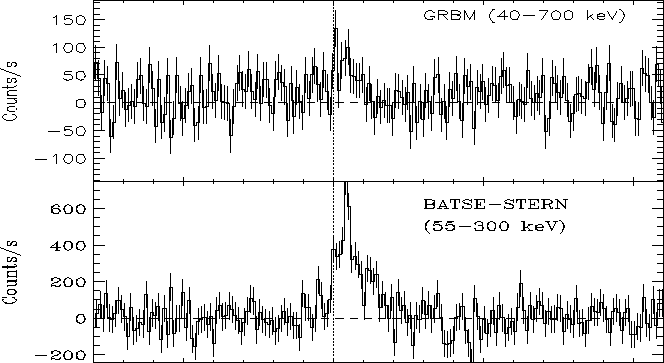



Next: The Coincidence Interval
Up: The off-line Quest
Previous: The Visibility Parameter
Contents
Cross-check with other GRB Catalogs
One of the main differences with respect to the on-line quest
is represented by the automatic cross-checks with other GRB catalogs,
derived from other missions and/or experiments: whenever a candidate
burst is automatically found, the quest algorithms perform
a search for simultaneous events throughout the other GRB catalogs.
When a burst is found to be in common with others, it is classified
as common burst candidate, and some useful informations derived, like
the burst direction, are referred to the BeppoSAX local frame of reference,
to check whether the two bursts, i.e. the GRBM candidate and the
simultaneous one from other catalogs, are really the same burst.
The catalogs used for the cross-check can be divided into two
classes: the first includes all the bursts, that have been localized
with high accuracy (typically  few arcmin.):
this mainly includes WFC GRBs (table
few arcmin.):
this mainly includes WFC GRBs (table ![[*]](crossref.png) ),
IPN bursts (table
),
IPN bursts (table ![[*]](crossref.png) ), and other bursts from the
ASM/Rossi-XTE and HETE-II.
The second class includes the catalogs, whose GRB directions are
affected by intermediate uncertainties (
), and other bursts from the
ASM/Rossi-XTE and HETE-II.
The second class includes the catalogs, whose GRB directions are
affected by intermediate uncertainties ( few degrees):
first of all, the BATSE 4B catalog
few degrees):
first of all, the BATSE 4B catalog
![[*]](footnote.png) ;
then, two catalogs including BATSE non-triggered bursts
have been taken into account as well: the Kommers' catalog
;
then, two catalogs including BATSE non-triggered bursts
have been taken into account as well: the Kommers' catalog
![[*]](footnote.png) ([Kommers et al., 1999]) and the Stern's catalog
([Kommers et al., 1999]) and the Stern's catalog
![[*]](footnote.png) ([Stern et al., 2000b]).
([Stern et al., 2000b]).
Since these two BATSE non-triggered bursts catalogs mainly
include faint events, whose burst nature could be not so well
established in some cases, they have been often used with caution.
Obviously, the search for bursts in common with BATSE has been
limited to the time interval, during which both the GRBM and BATSE
were operating, i.e. from July 1996 (when the first scientific
observations started) to June 2000 (when the CGRO was driven into
the ocean).
To better give an idea of the pieces of information automatically yielded,
whenever a burst candidate is found to be simultaneous with bursts
from other catalogs, below we report the case of GRB961228,
occurred at UT 00:29:58, that triggered both the GRBM and BATSE
(trigger # 5729; see fig. ![[*]](crossref.png) ).
).
[4]
------------------------------------------------------------------
Sun R.A. and Dec.: 276.0 -23.3
Sun LS phi : 24.8
Sun LS theta: -13.8
LSra: 36.3 298.9 216.3 118.9
LSde: -7.5 -44.4 7.5 44.4
lkGRB[0] #LSs: 4 Good HRR: 6
Trigger Time (UTC): 88198.2 28 Dec 1996 00:29:58
Sun visib.: 2
Earth Phi: 275.1 Theta: -10.5
LS E-elev: -54.5 18.8 102.2 28.9
LS Ecos : 0.979 0.088 -0.979 -0.088
......onboard trigger delay: 0 (obs.: 23)
*********BATSE burst delay: -26
GRB E-elev: 45.5
GRB visib.: 2
GRB phi: 42.4 theta: 70.6
Nsig(trg): 6.4 4.0 2.9 2.1 3.5 3.3 2.5 1.8
Nsig(pfl): 11.1 8.9 7.1 6.8 8.2 7.2 5.7 4.7
Bkg lev. : 846 1229 918 842 988 1029 950 1039
ChiSq R. : 1.269 1.203 0.948 1.043 1.079 1.146 1.024 1.062
Peak fl. : 323 311 216 198 259 231 177 152
Error : 44.9 52.7 45.4 43.4 47.3 47.9 45.6 47.3
Fluence : 4357 3993 2700 2551 3035 2878 2047 1819
Error : 208.3 230.8 198.8 181.5 220.4 210.1 200.4 198.3
Dur (s) : 26.00 20.00 20.00 18.00
Abundance: 23 20 20 18
H. Ratio : 0.696 0.721 0.758 0.713
HR Ratio : 0.966 0.919 0.977 0.951 1.011 1.063
HR W-ave : 0.716 +/- 0.037
GRBM-AC angle (deg): 1.6
------------------------------------------------------------------
First of all, this burst triggered the on-board logic,
then the delay between the S/W trigger time and the BATSE trigger
time is given in the line with several asterisks: in this case, BATSE
was triggered  26 s before the GRBM.
The burst geometry, according to the BATSE estimate of the arrival
direction, is then reported in the next lines: in particular, the
parameter called ``GRB E-elev'' expresses the elevation angle above
the Earth limb of the BATSE direction (in this case:
26 s before the GRBM.
The burst geometry, according to the BATSE estimate of the arrival
direction, is then reported in the next lines: in particular, the
parameter called ``GRB E-elev'' expresses the elevation angle above
the Earth limb of the BATSE direction (in this case:
 ).
The GRB visibility is calculated, according to the definition
given in the previous section, with only one remark: while for WFC or IPN
bursts the error box can be neglected for our aims, when dealing
with BATSE bursts it cannot be neglected any
more. Since, in such cases, we deal with point-like sources with
error regions, instead of extended sources like in the case of the Sun
discussed before, then we
have to little adjust the visibility definition for BATSE bursts, as follows:
).
The GRB visibility is calculated, according to the definition
given in the previous section, with only one remark: while for WFC or IPN
bursts the error box can be neglected for our aims, when dealing
with BATSE bursts it cannot be neglected any
more. Since, in such cases, we deal with point-like sources with
error regions, instead of extended sources like in the case of the Sun
discussed before, then we
have to little adjust the visibility definition for BATSE bursts, as follows:
 |
(32) |
Figure:
GRB961228, UT 00:29:58, is an example of a GRBM-BATSE common burst.
Upper panel: GRBM 40-700 keV light curve (summed counts of all units);
lower panel: BATSE  keV light curve.
keV light curve.
 |
Thus, when the whole error circle is not Earth-blocked, the burst is
said to be ``surely visible''; on the other side, when this is entirely
Earth-blocked, the burst is said ``surely occulted''.
In the remaining cases, i.e. when the error circle is partially occulted,
the burst is called ``probably occulted'' and ``probably visible'', when
the burst position is Earth-blocked or not, respectively.
Figure:
GRB980923, UT 08:22:58, is an example of a GRBM-Stern's BATSE
common burst. Upper panel: GRBM 40-700 keV light curve (unit 3);
lower panel: BATSE  keV light curve as taken from Stern's catalog
(event identificator: 11079d).
keV light curve as taken from Stern's catalog
(event identificator: 11079d).
 |
Subsections




Next: The Coincidence Interval
Up: The off-line Quest
Previous: The Visibility Parameter
Contents
Cristiano Guidorzi
2003-07-31
![[*]](crossref.png) ),
IPN bursts (table
),
IPN bursts (table ![[*]](crossref.png) ), and other bursts from the
ASM/Rossi-XTE and HETE-II.
The second class includes the catalogs, whose GRB directions are
affected by intermediate uncertainties (
), and other bursts from the
ASM/Rossi-XTE and HETE-II.
The second class includes the catalogs, whose GRB directions are
affected by intermediate uncertainties (![[*]](footnote.png) ;
then, two catalogs including BATSE non-triggered bursts
have been taken into account as well: the Kommers' catalog
;
then, two catalogs including BATSE non-triggered bursts
have been taken into account as well: the Kommers' catalog
![[*]](footnote.png) ([Kommers et al., 1999]) and the Stern's catalog
([Kommers et al., 1999]) and the Stern's catalog
![[*]](footnote.png) ([Stern et al., 2000b]).
([Stern et al., 2000b]).


